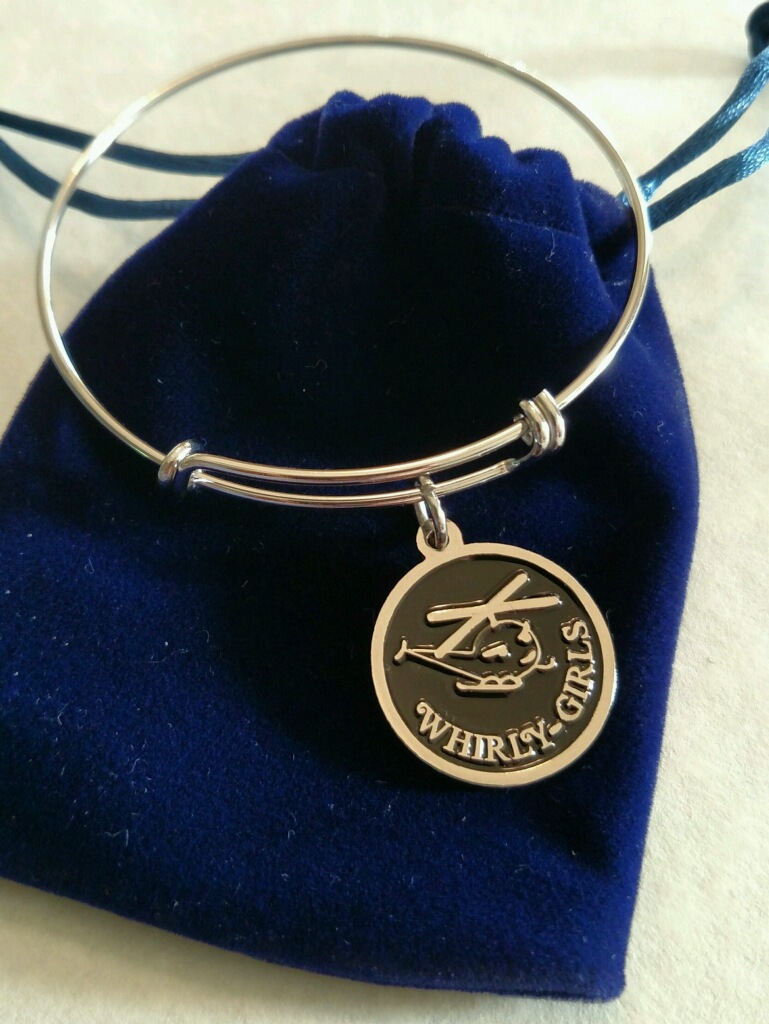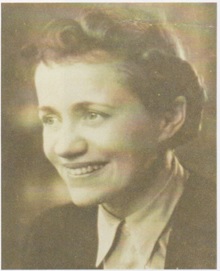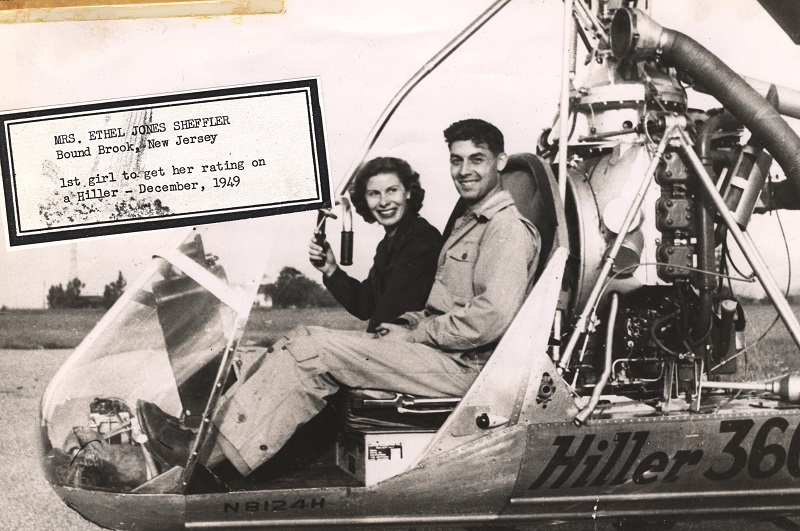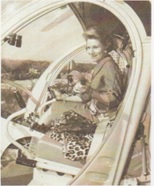History of the Whirly-Girls

Jean Ross Howard with flight instructor Roger Kaadtman after her first solo
Why the Whirly-Girls?
Jean Ross Howard Phelan and 12 other charter members representing women helicopter pilots from France, Germany and the United States were the first to call themselves the Whirly-Girls. On April 28, 1955, Jean founded the Whirly-Girls in hopes of developing an organization where female pilots could share information and camaraderie regardless of country, race, religion, or politics.
Jean obtained her helicopter rating at Bell Helicopter School in Fort Worth, Texas, now Bell Helicopter Textron, in June 1951. Lawrence Bell was the first commercial helicopter manufacturer. He used to tease Jean and called her Whirly-Girl while she trained for her helicopter rating. Jean and Mr. Bell thought the world of one another, and they shared many laughs. She decided to name the organization “Whirly-Girls” out of respect for Mr. Bell. Some of the original charter members were less than excited about the name until they found out that it came from Lawrence Bell.
Years later, the Whirly-Girls membership brought a name change up for vote. It was soundly defeated. Whirly-Girls is still used today as a tribute to both Jean Ross Howard Phelan and Lawrence Bell.
Whirly-Girls Numbers
Once a woman earns her initial private or rotorcraft add-on certificate, she can apply to be a member and is given her Whirly-Girls number.
For many years, that number correlated with how many women helicopter pilots were licensed in the world. For example, WG#5 was the fifth woman in the world to get her helicopter rating, and Jean herself was WG#13. Now, however, it is an indication of how many women helicopter pilots have chosen to affiliate themselves with the Whirly-Girls International.
The Whirly-Girls Logo
In the early 1950s, the U. S. Аrmy used an innovative way to recruit needed pilots: they created a Helicopter Square Dance Team with four Bell 47s (what the army called H-13s). Two were painted as boys, wearing straw hats with pipes in their painted-on mouths. The other two were painted like girls with blond wigs made from dyed floor mops, and faces painted with lashes and red lips.
The windshields looked like faces, with painted oil cloths taped inside the bubble. The skirts covering the skids were made of target practice cloth. With a caller on the mic and the band playing “Turkey In The Straw,” the helicopter team would perform fast dance maneuvers with the rotors whirling: “Ladies Do-Si-Do,” “Allemande Left.” Air show crowds and TV audiences watched with fascination. (See video below.)

Members of the Helicopter Square Dance Team
When charter member WG#9 Marilyn Riviere and I first saw the helicopter dance team in action, we instantly agreed to adopt the lady helicopter as the Whirly-Girls logo. Next, we trademarked the logo so we could use it on items to sell for our Scholarship Fund. The rest is history.
Harry E. Gilliand, aka "Ned," was one of the former helicopter girl square dancer pilots and later captain of the U.S. Team at the third World Helicopter Championships. He published a book entitled Dancing Rotors in which he identifies the Whirly-Girls logo.
What About the Medallions?
When a female pilot becomes a Whirly-Girl, she is assigned a Whirly-Girl number and receives a medallion with the Whirly-Girl logo. As the story goes, Howard Hughes had 50 medallions made with the Whirly-Girl logo for the first female helicopter pilots. There were 50 because he found it unlikely there were going to be more than 50 women flying helicopters.
We continue this tradition of issuing a medallion to each new Whirly-Girl.

Whirly-Girls Events Timeline
April 28, 1955First Whirly-Girls Meeting
Jean Ross Howard and five other female helicopter pilots met for the first time at the Mayflower Hotel in Washington, DC. The result was the formation of The Whirly-Girls organization. Membership numbers were assigned to the 13 known female helicopter pilots worldwide based on when they earned their helicopter ratings. In the early years of The Whirly Girls, Jean handled all of the administrative tasks for the organization including recruiting new members, ordering membership badges, writing the newsletter, publishing press releases, and planning annual “hovering” and social gatherings.May 1961Invitations and Meetings
The Whirly Girls were invited to meet with President John F. Kennedy at The White House. They were also invited to meet with Igor Sikorsky, the inventor of the first practical helicopter and the founder of Sikorsky Helicopter in Stamford, Connecticut. In the early 1960s, the Whirly Girls gathered on the steps of the U.S. Capitol to have their photo taken with President Kennedy. At this time, the Whirly Girls annual hoverings occurred in conjunction with the annual meeting of the American Helicopter Society (AHS).1968Annual Hovering with HAA/HAI
This is the first year that the Whirly-Girls began having our annual meeting and “hovering” in conjunction with the Helicopter Association International (then Helicopter Association of America). The 1968 meeting of HAA was in Las Vegas, NV.November 20, 1973Non-Profit Status
The Whirly Girls Scholarship Fund, Inc. was established as a separate non-profit organization for the express purpose of awarding helicopter flight training scholarships to women desiring a career in the helicopter industry.February 10, 198025th Anniversary
The Whirly-Girls celebrated their 25th anniversary in Las Vegas, NV. At that time, the organization had approximately 295 members.November 10, 1987Whirly-Girls at the Smithsonian
The Whirly-Girls were invited by the Smithsonian National Air & Space Museum to have an exhibit in the Vertical Takeoff & Landing (VTOL) section of the museum. Several years later, the exhibit was dismantled to make room for new exhibits.October 1, 1994Published History
Author Henry Holden wrote the first book exclusively about the Whirly-Girls, entitled Hovering: The History of the Whirly-Girls. Used copies are available on Amazon.com. Many of our longtime members were interviewed for inclusion in this book.April 3, 2012Whirly-Girls Archive at Texas Woman's University
A formal agreement was executed with The Woman’s Collection at Texas Woman’s University (TWU) to establish an initial $10,000 endowment fund for the purpose of maintaining and digitizing the Whirly Girls archival collection. We are grateful to TWU for permission to include some of these digitized images on this and other pages of our website.February 28, 2016Record-Breaking Scholarship Season
In 2016, the Whirly-Girls scholarship program achieved record numbers: the scholarship committee received 247 applications from 67 women and awarded 28 scholarships to well-deserving and qualified female pilots. With the generous support of the scholarship sponsors, the number of Whirly-Girls scholarships doubled from the previous year, totaling $175,000 in value. Scholarships were presented at the Whirly-Girls Annual Awards Banquet in Louisville, Kentucky.March 3, 2019Another Extraordinary Scholarship Season
With the help of generous sponsors, the Whirly-Girls awarded 15 different scholarships with a total value of $235,000 to 24 women. Presentations took place on March 3, 2019 at the annual Whirly-Girls Awards Banquet during HAI HELI-EXPO in Atlanta, Georgia. Applications were submitted from 67 women, a quarter of whom were citizens of another country: Austria, Belgium, Canada, the Czech Republic, Denmark, France, Germany, Ireland, Malaysia, New Zealand, Russia, South Africa, and the UK.2020-2021Whirly-Girls Go Virtual
During the COVID pandemic, the first ever virtual Whirly-Girls awards ceremony was live-streamed in March, 2021 without a hitch: the Whirly-Girls and generous sponsors recognized 14 scholarship recipients out of the 73 women who applied. Hoverings and informational sessions were held via Zoom throughout 2020 and 2021 as members gathered virtually from around the world.
The First Thirteen Charter Members of the Whirly-Girls

WG#1 Hanna Reitsch

WG#2 Ann Carter

WG#3 Pat Swenson

WG#4 Nancy LIvingston Stratford

WG#5 Marilyn “Lyn” Grover Heard Alexander

WG#6 Dr. Valerie Andre
In 1950 she became a helicopter pilot and flew 150 medical missions, notably during the siege of the fortress of Dien Bien Phu. She received many military decorations including the Legion d’ Honour, seven citations of the croix de guerre, the U.S Legion of Merit, the Cross of Valour (Vietnam), and was medical chief of a helicopter squadron.
She flew 129 helicopter rescue missions and made two parachute jumps under combat conditions during the French-Indo China War in the early 19050s. She picked up critically wounded soldiers, fly them to a safe field hospital, and occasionally performed their life-saving surgery. MASH units were later based on her example. She spent 33 years on active duty with the French Air Force and retired in 1981 to become France’s medical inspector general. She wrote two memoirs.

WG#7 Ethel Sheffler

WG#8 Mme. Jacqueline Auriol

WG#9 Marilyn Himes Riviere

WG#10 Edna Gardner Whyte
In her late sixties, she planned to start an airport in Texas but was denied a bank loan. Undeterred, she borrowed money from friends and blazed a runway across a cotton field. She received numerous aviation awards including the Charles Lindberg Lifetime Achievement Award. In 1984, she was inducted into the Oklahoma Aviation and Space Hall of Fame for her lifetime contributions to aviation.

WG#11 Clara Livingston

WG#12 Mary Rosholt

WG#13 Jean Ross Howard Phelan
From 1941 to 1943, Jean was employed as pilot-secretary to the combined office of Aeronca Aircraft Corp., Piper Aircraft Corp., and Taylorcraft Aviation, Inc., in Washington. In 1943, she served as a student-trainee with the Women’s Airforce Service Pilots (WASP). She later received an application for enrollment as an officer candidate in the WAVES, the United States Naval Reserve (Women’s Reserve) from Lt. Comdr. Gerald C. Gross. During World War II Jean served with the American Red Cross as Program Director of the Air Force Rest Camp on the Isle of Capri.
In 1949, she was appointed First Lieutenant with the Civil Air Patrol. She participated in two transcontinental air races and in one international air race. In 1952 she was appointed an Arthur Godfrey Air Fellow which entitled her to thirty-five hours of flying instruction from Ashburn Flying Service at the Alexandria Airport in Alexandria, Virginia. She also became a lifetime member of the Flying Turtle Club after completing the Transcontinental Course from Santa Ana, California, to Wheeling, West Virginia, in the All-Woman Transcontinental Air Race of 1952.
In 1953, James H. Doolittle, Chairman of the National Committee to Observe the 50th Anniversary of Powered Flight, commended Jean Ross Howard for distinguished service to aviation during the Golden Jubilee Celebration of Orville and Wilbur Wright’s first heavier-than-air controlled powered flight. She founded the Whirly-Girls in 1955 and encouraged women from all over the world to become helicopter pilots, supporting their love of flying throughout her lifetime.

